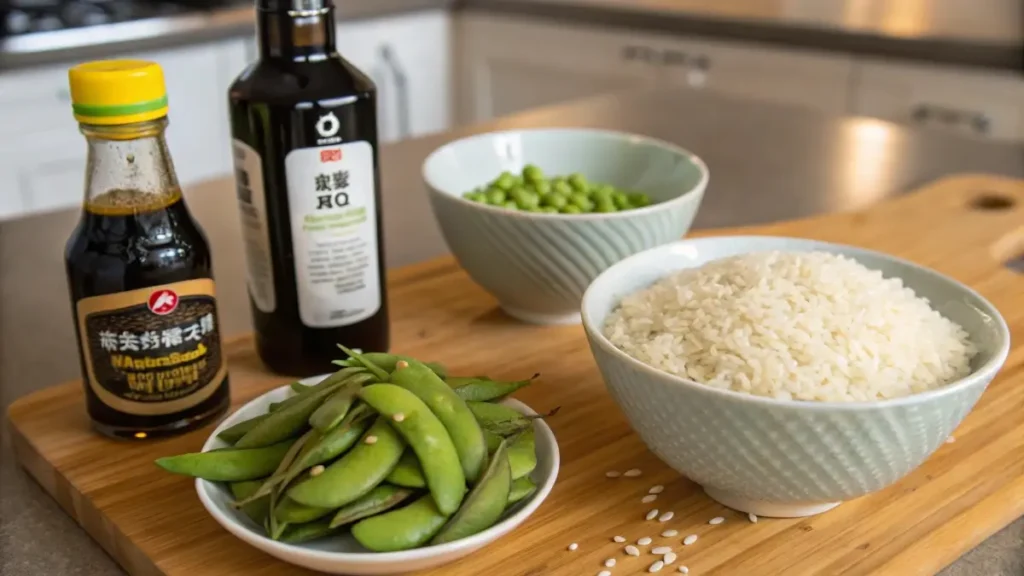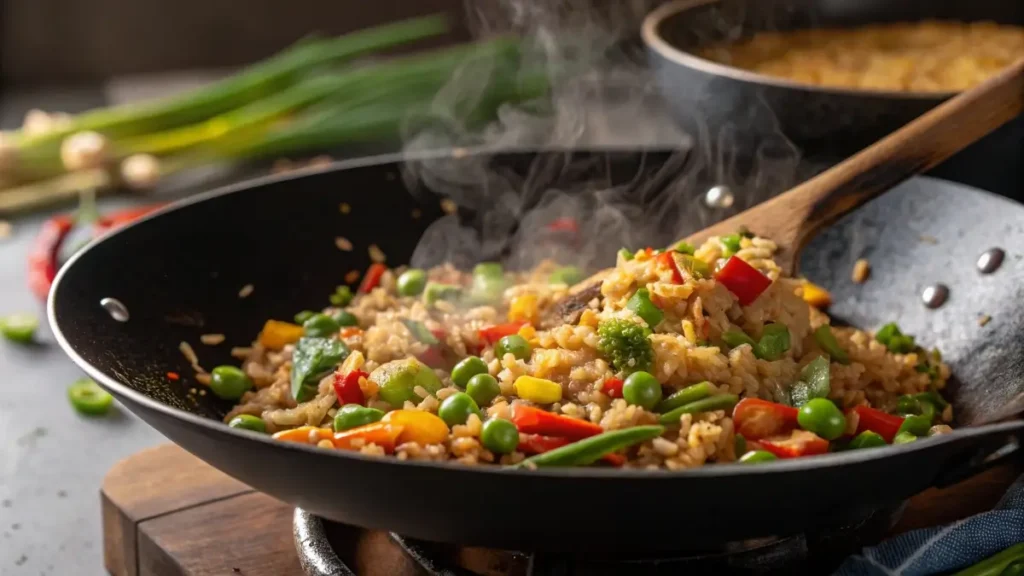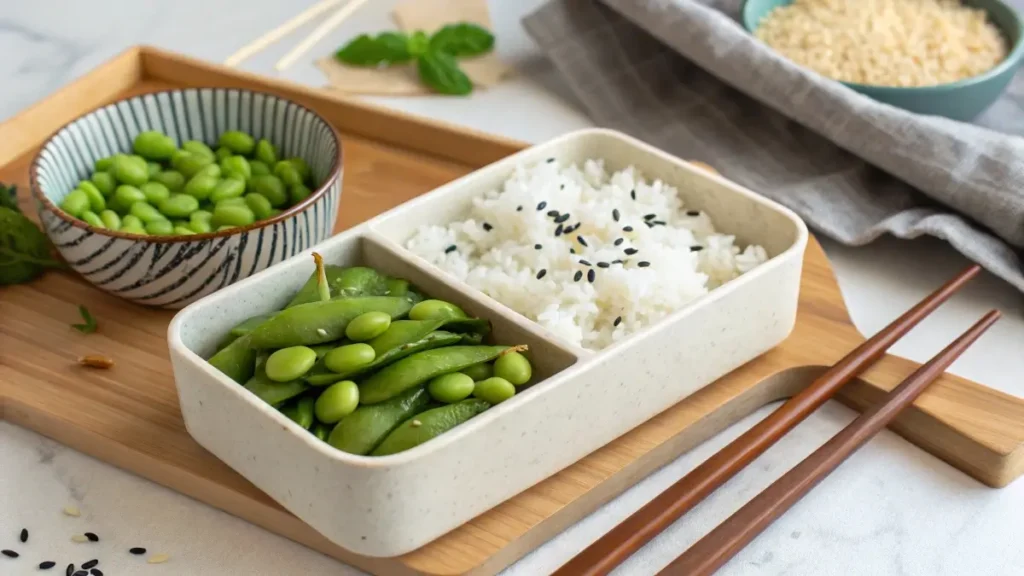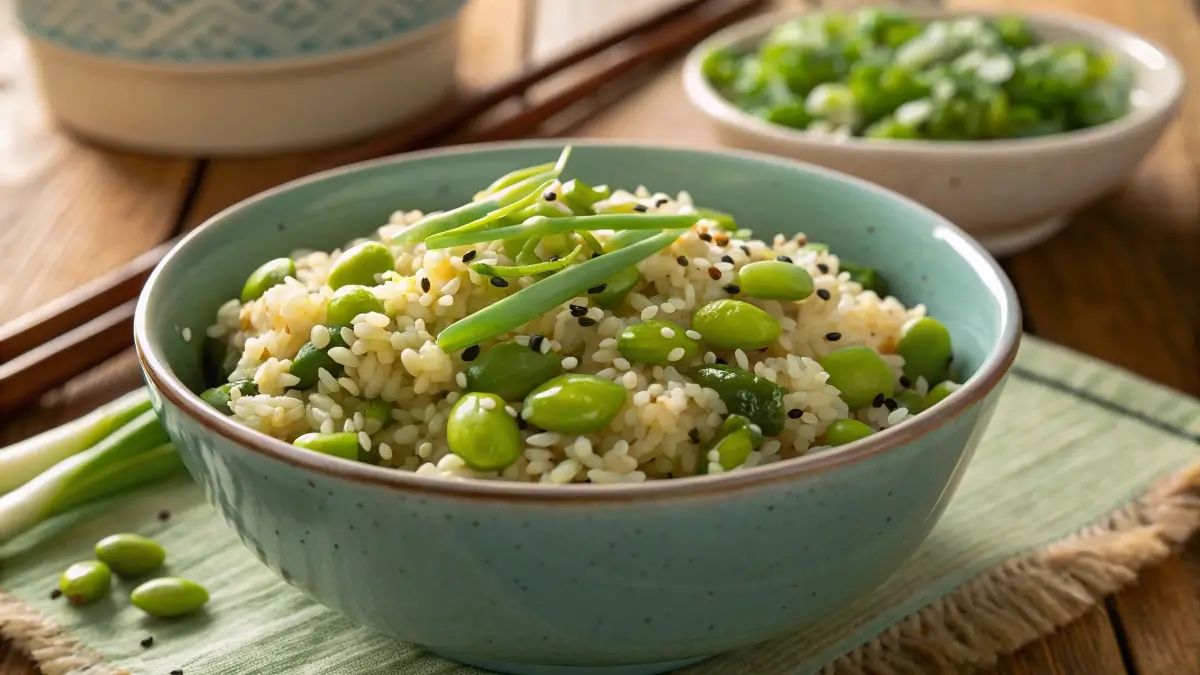Edamame Rice Recipe: The Ultimate Guide to a Flavorful and Healthy Dish
If you’re looking for a simple yet nutritious meal that blends taste with health, the edamame rice recipe might just become your new favorite go-to dish. With roots in Asian cuisine, this vibrant combination of tender rice and protein-rich edamame beans delivers not only a delightful texture but also impressive health benefits. In this comprehensive guide, you’ll discover everything from the origins of edamame rice recipe to how you can whip up your own bowl in no time. We’ll walk you through its nutritional perks, popular pairings, cooking tips, and etiquette—ensuring your next meal is both delicious and culturally respectful. Looking for inspiration? Try this collection of easy edamame recipes for more ideas that complement what you’ll find here.
Table of Contents
Introduction to Edamame Rice Recipe
What is Edamame Rice? A Simple Definition
Edamame rice is a dish that combines steamed or cooked rice with young green soybeans, known as edamame. These beans, harvested before they harden on the plant, are prized for their slightly sweet taste and soft, buttery texture. Typically served warm or at room temperature, edamame rice recipe can be a main dish or a hearty side. The simplicity of the edamame rice recipe allows home cooks to customize it with additional ingredients like sesame seeds, seaweed, or sauces, creating a versatile and satisfying meal. This dish is popular not only for its flavor but also for its nutritional value, as it merges plant-based protein with the energy-giving carbs of rice.
Origins and Cultural Significance of Edamame in Rice Dishes
Edamame, the Japanese term for immature soybeans, has been a staple in East Asian diets for centuries. While edamame is often served as a snack or appetizer, combining it with rice stems from the traditional approach of creating well-balanced meals using simple, whole ingredients. In Japan and parts of China, edamame rice recipe is cherished for its balance of taste and nutrition, often appearing in bento boxes, casual family dinners, and festive gatherings. The edamame rice recipe reflects values of harmony and seasonality in cooking—making the most of fresh ingredients at their peak. Today, edamame rice recipe enjoys global popularity as health-conscious diners seek meals that are both easy to prepare and rich in nutrients.
Benefits of Edamame in Your Rice
Nutritional Profile: Why Edamame is a Superfood
When you add edamame to rice, you’re boosting your meal’s nutritional value in a big way. Edamame is often called a plant-based superfood because it’s packed with high-quality protein, fiber, and essential vitamins and minerals. Just one cup of cooked edamame delivers about 17 grams of protein, making it an excellent choice for vegetarians, vegans, or anyone looking to reduce meat consumption. It’s also rich in folate, iron, calcium, magnesium, and vitamin K. Pairing these nutrient-dense beans with rice creates a complete protein, offering all nine essential amino acids in one dish. That’s why so many health-conscious cooks swear by this edamame rice recipe as a staple for meal prep.
In the table below, see how edamame compares to other common rice add-ins:
| Nutrient | Edamame (1 cup) | Peas (1 cup) | Corn (1 cup) |
|---|---|---|---|
| Protein (g) | 17 | 8 | 5 |
| Fiber (g) | 8 | 7 | 4 |
| Iron (mg) | 3.5 | 2.1 | 0.5 |
| Calcium (mg) | 98 | 36 | 3 |
As you can see, edamame easily outshines these other popular rice mix-ins for protein and mineral content.
Health Benefits: From Protein Boost to Heart Health
The health benefits of edamame rice recipe go beyond simple nutrition numbers. First, the plant protein in edamame supports muscle repair and maintenance, making this dish a smart post-workout meal. Next, the fiber helps with digestion and can contribute to feeling full longer, which may aid in weight management. What’s more, edamame contains heart-healthy isoflavones, natural compounds that may help lower cholesterol and reduce the risk of heart disease when part of a balanced diet. Combining edamame with rice also helps stabilize blood sugar levels, thanks to its mix of fiber and complex carbohydrates. Discover great ideas like cilantro lime rice in a rice cooker that can inspire your next fusion creation with edamame.
Adding edamame to your rice isn’t just about taste—it’s a small change with big benefits for your overall well-being.
How to Make Edamame Rice Recipe at Home

Essential Ingredients for a Perfect Edamame Rice Recipe
Creating a satisfying edamame rice recipe at home starts with gathering fresh, quality ingredients. The beauty of this dish is that it requires only a handful of staples, and you can always customize it to suit your taste. Here’s what you’ll need for a basic version:
| Ingredient | Quantity | Notes |
|---|---|---|
| White or brown rice | 1 cup (uncooked) | Jasmine or short-grain works well |
| Edamame (shelled) | 1 cup | Fresh or frozen, both work fine |
| Water or vegetable broth | As needed | For cooking the rice |
| Sesame oil | 1 tablespoon | Adds a nutty aroma |
| Soy sauce or tamari | 2 tablespoons | Adjust to taste |
| Green onions | 2 stalks, chopped | Optional for garnish |
| Sesame seeds | 1 teaspoon | Optional for topping |
You can also try adding garlic, ginger, or a splash of rice vinegar to brighten up the flavor. Many home cooks enjoy blending edamame rice recipe with ingredients from other dishes, like those found in this authentic Spanish rice guide, for a fusion twist.
Step-by-Step Cooking Instructions for Beginners
Here’s a simple way to prepare a flavorful edamame rice recipe at home:
- Rinse the rice well under cold water until the water runs clear. This helps the rice cook up light and fluffy.
- Cook the rice in a pot or rice cooker with water or broth, following package directions.
- Boil or steam the edamame until heated through—about 3-5 minutes if frozen, 2-3 minutes if fresh. Drain well.
- Mix the edamame into the cooked rice while it’s still warm. Add soy sauce, sesame oil, or your favorite seasoning to taste.
- Top and serve. Sprinkle with sesame seeds, green onions, or nori strips for extra flavor and texture.
Tip: For a one-pot version, layer frozen edamame on top of the rice before cooking and let it steam together.
Looking for a twist? Check out our authentic Spanish rice to inspire fusion creations with edamame.
Can You Cook Edamame Beans with Rice?
Cooking Edamame Together with Rice: Pros and Cons
One of the most common questions home cooks ask when preparing an edamame rice recipe is whether you can cook the edamame and rice together in the same pot or rice cooker. The short answer? Yes, but with a few considerations.
Pros:
- Cooking both together saves time and reduces cleanup.
- The edamame infuses the rice with a subtle nutty flavor.
- It’s an easy one-pot solution, ideal for busy weeknights.
Cons:
- The cooking times for rice and edamame can differ, depending on the type of rice and whether you’re using fresh or frozen edamame.
- Overcooked edamame can become mushy, losing its signature texture.
For best results, many cooks prefer to steam or blanch the edamame separately and fold it into the cooked rice at the end. This method helps retain the bright color and firm bite that makes edamame so appealing.
Best Cooking Methods for Combined Edamame and Rice Dishes
If you’d like to cook edamame and rice together, here’s a simple method to try:
- Rinse your rice and add it to your rice cooker or pot with the appropriate amount of water or broth.
- Add frozen shelled edamame on top of the rice—do not stir in. This helps the edamame steam rather than boil, which can help preserve its texture.
- Cook as usual. Most rice cookers and stovetop rice recipes will produce good results without altering timing.
- Fluff and season. Once cooked, gently mix the edamame into the rice, then season as desired with soy sauce, sesame oil, or other flavors.
Check out ranch chicken and rice for another easy rice-based meal idea that can inspire your kitchen experiments.
This method is a great starting point, but feel free to adjust based on your preference for firmer or softer edamame. It may take some experimenting, but you’ll eventually land on the flavor combo that’s perfect for you.
What Does Edamame Pair Well With?
Top Vegetables and Spices That Complement Edamame Rice
If you’re wondering what to serve alongside your edamame rice recipe, the options are endless. Edamame’s mild, nutty flavor makes it a natural match for a variety of vegetables and seasonings. Here are some top choices:
- Carrots and bell peppers: These colorful veggies add sweetness and crunch, balancing the soft texture of edamame.
- Mushrooms: Earthy and rich, mushrooms bring depth to the dish.
- Broccoli and snap peas: These green veggies enhance the meal’s nutritional profile while keeping the color palette vibrant.
- Ginger and garlic: Both add zing and warmth that pair beautifully with the subtle flavor of edamame.
- Sesame seeds and seaweed: Classic garnishes that boost both taste and presentation.
A sprinkle of chili flakes or a drizzle of sriracha can also give your bowl a spicy kick. Looking for inspiration? Try ideas from our easy stuffed peppers with beef and rice and modify them for a plant-based twist.
Protein Pairings: Tofu, Chicken, and More
Although the edamame rice recipe already offers a solid source of plant protein, you can easily bulk it up further. Here are some delicious protein pairings:
- Tofu: Pan-fried or baked tofu cubes absorb sauces beautifully and complement edamame’s texture.
- Grilled chicken: A lean, juicy option that blends seamlessly with the dish’s flavors.
- Shrimp: A quick-cooking protein that adds a hint of sweetness and briny taste.
- Egg: A soft-boiled or fried egg on top transforms edamame rice recipe into a filling meal.
These pairings turn a simple bowl of rice into a complete and satisfying entrée that works for lunch, dinner, or meal prep.
When combining proteins, think about flavor harmony—light soy glaze, teriyaki sauce, or miso dressing work wonders here.
Using Frozen Edamame in a Rice Cooker
Is Frozen Edamame Suitable for Rice Cookers?
Absolutely! One of the reasons many home cooks love this edamame rice recipe is its versatility. Frozen edamame works perfectly in a rice cooker, making the dish even more convenient for busy weeknights. Since most frozen edamame is pre-cooked or blanched before freezing, it only needs to be heated through rather than fully cooked. This means you can add it to your rice cooker without worrying about extra cooking time.
What makes frozen edamame ideal?
- It’s available year-round and easy to store.
- It saves on prep work—no shelling or trimming required.
- It cooks evenly with rice in most standard rice cooker settings.
To ensure the best texture, consider adding frozen edamame to your rice cooker about halfway through the rice’s cooking cycle if you prefer a firmer bite.
Tips for Perfectly Steamed Edamame with Rice
Here are some pro tips to get the most from your frozen edamame and rice combo:
- Layer the edamame on top of the rice rather than mixing it in at the start. This helps the edamame steam gently rather than boil.
- Don’t overdo the water. Rice cookers are precise, so stick to the recommended liquid measurements for your chosen rice type.
- Add seasoning at the end. Drizzle on soy sauce, sesame oil, or miso dressing after cooking for a fresh, bright flavor.
- Give it a gentle stir. After cooking, lightly mix to distribute the edamame without breaking up the rice grains.
Looking for other one-pot rice ideas? Don’t miss our delicious carnivore diet recipes for inspiration that you can adapt with plant-based swaps like edamame.
By using frozen edamame, you can enjoy a quick, nutrient-packed meal with minimal effort—and all the flavor!
Edamame in Fried Rice: A Delicious Twist

How to Make Edamame Fried Rice at Home
If you’re craving something more flavorful and hearty, turning your edamame rice recipe into fried rice is a fantastic option. Edamame pairs beautifully with classic fried rice ingredients, offering a pop of color and a protein punch.
Here’s a simple method to whip up edamame fried rice in under 20 minutes:
- Start with cold, cooked rice. Day-old rice works best because it’s less sticky and fries up nicely.
- Heat sesame or vegetable oil in a wok or large skillet over medium-high heat.
- Add aromatics like minced garlic, ginger, or chopped onions and sauté until fragrant.
- Toss in your edamame. If using frozen, no need to thaw—it will warm up quickly in the pan.
- Move the ingredients to one side of the pan, scramble an egg in the open space if you like, and then stir everything together.
- Add the rice, soy sauce, and any extras like carrots, peas, or diced bell peppers. Stir-fry for 3-5 minutes until heated through and slightly crispy.
- Finish with green onions, sesame seeds, or a drizzle of sriracha.
Fried rice with edamame is not only easy but endlessly customizable. For more inspiration, discover great ideas like our delightful Asian desserts to pair with your meal.
Best Sauces and Add-ins for Edamame Fried Rice
The secret to standout edamame fried rice? The right sauces and mix-ins. Here are some reader favorites:
- Low-sodium soy sauce or tamari: For savory depth without overwhelming saltiness.
- Hoisin or teriyaki sauce: A touch of sweetness that balances edamame’s earthiness.
- Chili oil or sriracha: For those who love a spicy kick.
- Fresh herbs: Cilantro or Thai basil add freshness and fragrance.
- Pineapple or mango chunks: A fun, tropical twist for sweet-salty contrast.
Experiment with combinations that suit your taste, and don’t hesitate to use leftover veggies or proteins from other dishes.
Is Edamame Healthy or Unhealthy?
Debunking Myths About Edamame’s Health Effects
There’s plenty of buzz around edamame—and sometimes, a little confusion too. So, is edamame healthy or unhealthy? The short answer: edamame is a nutrient-dense, healthful addition to your diet, especially when featured in dishes like our edamame rice recipe.
Some myths suggest that edamame, being a type of soybean, may negatively affect hormone balance because of its natural plant compounds called isoflavones. However, research shows that consuming moderate amounts of edamame as part of a balanced diet is safe for most people and may even offer health perks.
Key reasons edamame supports good health:
- Heart health: The isoflavones in edamame have been linked to reduced cholesterol levels.
- Weight management: High in fiber and protein, edamame helps you feel full longer.
- Bone strength: Rich in calcium and magnesium—important minerals for bone density.
- Plant-based protein: It’s a complete protein source, ideal for vegetarians and vegans.
In short, including edamame in your rice dishes is a smart move for most diets. And if you want more inspiration, check out delicious spiced Cajun turkey recipe for ideas on balancing plant and animal proteins in your meals.
Edamame and Dietary Restrictions: What You Should Know
If you’re managing specific dietary needs, here’s how edamame fits:
- Gluten-free: Naturally gluten-free (just watch for cross-contamination in packaged or flavored versions).
- Low-carb and keto: Not ideal for strict keto, but fine for moderate-carb plans.
- Soy allergy: Avoid edamame if you have a soy allergy.
- Low FODMAP: Edamame can be high in FODMAPs when eaten in large quantities, so portion control matters for sensitive individuals.
When in doubt, consult your nutritionist or health provider to see how edamame fits your lifestyle.
Etiquette and Serving Tips for Edamame Rice Recipe

How to Serve Edamame Rice in Traditional and Modern Settings
Serving your edamame rice recipe isn’t just about taste—it’s also about presentation. In traditional Japanese meals, rice is often served in small bowls, accompanied by simple garnishes like sesame seeds, nori strips, or pickled vegetables. For a modern twist, you might plate edamame rice in a larger bowl as a base for a vibrant grain bowl, topped with fresh herbs, avocado slices, or a drizzle of miso dressing.
Other ideas for presenting your edamame rice recipe include:
- In bento boxes: A neat portion alongside grilled veggies, tofu, or chicken.
- As part of a buffet: A colorful, crowd-pleasing side that pairs with Asian-inspired mains.
- Meal prep containers: Perfect for grab-and-go lunches that stay fresh for days.
For more inspiration on blending traditional and modern food styles, check out bang bang salmon bites—another dish that pairs beautifully with edamame rice recipe.
Dining Etiquette: Eating Edamame the Right Way
When enjoying edamame—whether on its own or as part of a rice dish—it’s good to know a few etiquette tips:
- Don’t eat the pods. Don’t eat the edamame pods—the real treat is the tender beans inside. If serving unshelled edamame, encourage guests to squeeze or pop out the beans.
- Use chopsticks or a spoon. Both are acceptable for eating edamame rice recipe, depending on the setting.
- Avoid waste. In Japanese dining, finishing your rice and sides is seen as respectful and a sign of appreciation.
Whether you’re enjoying a casual meal at home or sharing your dish at a potluck, following these simple guidelines helps you serve and eat edamame rice recipe with confidence and respect.
Conclusion
With its vibrant color, satisfying texture, and impressive nutrition profile, the edamame rice recipe is a versatile dish that fits beautifully into any mealtime lineup. Whether you’re cooking for a quick weeknight dinner, prepping meals for the week, or serving guests at a gathering, this recipe offers endless possibilities. Experiment with add-ins, sauces, and pairings to make it your own. Looking for more rice-based inspiration? Check out our cilantro lime rice in a rice cooker for another easy and flavorful idea.
FAQs
Can you cook edamame beans with rice?
Yes, you can cook edamame beans with rice in the same pot or rice cooker. It’s a convenient method that saves time and dishes. For best texture, place edamame on top of the rice rather than stirring it in at the start. This allows the beans to steam rather than boil, preserving their tender bite.
What does edamame pair well with?
Edamame pairs wonderfully with a variety of vegetables like carrots, bell peppers, and mushrooms. It also complements proteins such as tofu, grilled chicken, shrimp, or even a soft-boiled egg. Edamame’s mild flavor makes it ideal for mixing with bold sauces like soy, teriyaki, or chili oil.
Can I put frozen edamame in a rice cooker?
Absolutely. Frozen edamame works well in a rice cooker. Just layer the frozen beans on top of the rice before cooking. Since most frozen edamame is pre-blanched, it will heat through as the rice cooks.
Is edamame good in fried rice?
Definitely! Edamame adds protein, texture, and vibrant color to fried rice. Simply toss it into the skillet along with your rice, veggies, and sauce for a quick, satisfying meal.
Are edamame beans healthy or unhealthy?
Edamame beans are healthy and packed with protein, fiber, vitamins, and minerals. They’re a great plant-based protein source and may help with heart health, digestion, and weight management.
What is the etiquette of eating edamame?
The etiquette is to eat only the beans inside the pod, not the pod itself. Pop out the beans using your fingers or teeth and discard the pod. When eating edamame rice recipe, use chopsticks or a spoon as appropriate for your setting.

